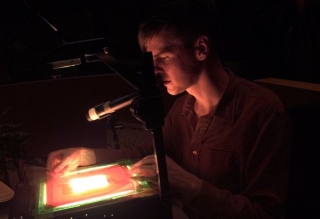Date: 23 October 2010 | Season: London Film Festival 2010 | Tags: London Film Festival
EVERY TIME I SEE YOUR PICTURE I CRY
Saturday 23 October 2010, at 7pm
London BFI Southbank NFT3
EVERY TIME I SEE YOUR PICTURE I CRY: A Live Performance by Daniel Barrow
Daniel Barrow has developed an intimate mode of ‘manual animation’ using the antiquated technology of an overhead projector. From a position amongst the audience, he recites live narration while manipulating layers of transparencies in continuous motion. Accentuated by interference patterns and sleight-of-hand trickery, Barrow’s hand-drawn images contrive an absorbing tale of comic book grotesques. EVERY TIME I SEE YOUR PICTURE I CRY is a bizarre confessional detailing the grand but hopeless scheme of an estranged garbage collector and failed art student. Unloved and rejected by society, the protagonist begins a universal art project in the form of a telephone directory of ‘profound and intimate insights’ to chronicle the lives of those around him. As he snoops through the windows and waste bins of fellow citizens, his survey is rendered futile by a maniacal killer who follows in his wake, picking off subjects one by one. Invoking introspection, pathos and dark humour, this award winning performance piece is accompanied by an unassuming Beach Boys-inflected score recorded by Amy Linton of The Aislers Set.
Daniel Barrow, Every Time I See Your Picture I Cry, Canada, 2008, 60 min
PROGRAMME NOTES
EVERY TIME I SEE YOUR PICTURE I CRY
Saturday 23 October 2010, at 7pm
London BFI Southbank NFT3
EVERY TIME I SEE YOUR PICTURE I CRY
Daniel Barrow, Canada, 2008, live performance, 60 min
Awarded the 2008 Images Prize at its premiere, Daniel Barrow’s ‘manual animation’ combines overhead projection with video, music, and live narration to tell the story of a garbage man with a vision to create an independent phone book chronicling the lives of each person in his city. In the late hours of the night, he sifts through garbage, collecting personal information and then traces pictures of each citizen through the windows of their homes as they sleep. What he doesn’t yet realize is that a deranged killer is trailing him, murdering each citizen he includes in his book, thus rendering his cataloguing efforts obsolete. The garbage man is a failed artist who fears becoming subject to the grip of something overwhelming. This animation traces his attempts to slow down and creatively reflect, in a process of coming to terms with his own self-loathing and fear.
www.danielbarrow.com
Every Time I See Your Picture I Cry. Yeah, that title makes me a little nauseated, too. And I would be lying if I said that wasn’t one of the many feelings that came to the surface in the midst of Daniel Barrow‘s show last night; funny, though, how nausea can feel so satisfying when paired with a helluva lot of other emotions. Barrow’s tour de force is notable in the way it combines many things: live narration, video, music, drawings and an overhead projector. Yes, a real, live overhead projector, unseen since your eighth grade biology class, on which Barrow layers and manipulates multiple transparencies. It is not the mere novelty of the tool that makes Barrow’s work worth it, but rather his complete and utter mastery of a machine more commonly considered a bygone clunker than a medium for high art. During a Q&A after the performance, he described a nun-cum-professor at his art school who had been giving the same, refined lectures for nigh on 50 years, conducted via slide and overhead projectors. Barrow was inspired to riff on her method as a parody, but soon found that the medium sincerely appealed to the ‘control freak’ and isolationist in him (‘I don’t like to work with crews, or other people, really,’ he admitted). The projector is the vehicle for Barrow’s harrowing, dreamscape-like tale of an erstwhile garbage man, art school dropout and social outcast. He spends his nights picking through residents’ detritus and peeking through their windows; he’s inspired, in his own earnest and perverse way, to create a special kind of phone book based on these findings. Each citizen will get a page of info and illustration; it’s an ‘art project for everyone,’ our garbage man intones. For reasons that remain hazy but may include childhood trauma and psychic revenge, it is slowly revealed that a serial killer stalks our stalker, the malicious and psychotic foil to his harmless voyeurism. But by the time this oddball is thrown into the mix, the audience is too thoroughly entrenchedin Barrow’s elegant, elegiac projector world to put up any sort of fight. Every Time I See Your Picture has a plot, but it is cushioned and obscured by the very narration around it, which is at once a diary entry, a cautionary tale and a philosophical tangent. A lot of it makes very little sense; some, in that illogical way personal confessions have, makes a frightening amount. Above all, though, this performance is ultimately enjoyed in the craft of the man and his machine. If the animation potential of an overhead projector has never entered your brain, see this and prepare for revelation. Barrow is fluid and holds perfect time; his narration matches the sweeping movements of transparencies placed and replaced, and the original score by Amy Linton buoys you up and into the garbage man’s musty-sherbet-toned world. I sat three rows behind Barrow (whose projection outpost is ensconced in the middle of the auditorium), and can heartily recommend this position. You watch the master make the product. It is a bizarre live experience, unlike any I’ve seen, unlikely to be forgotten any time soon. (Caitlin McCarthy, Willamette Week)
Back to top
